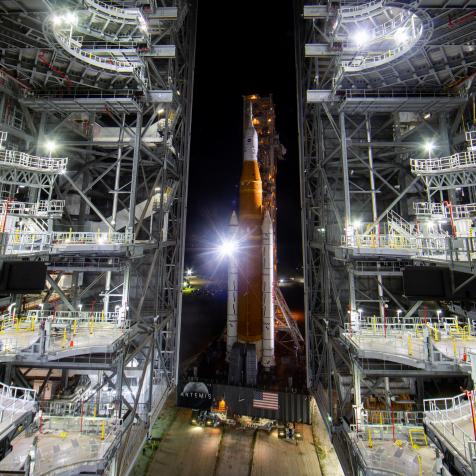
NASA
Astronomy’s Newest Tool: Artificial Intelligence

In a bowl, combine a tablespoon of hydrogen and a teaspoon of helium to a cup of dark matter. Add a pinch of neutrinos and sprinkling of radiation. Mix well to combine. Heat to several million Kelvin. When mixture has risen, leave to cool for 13 billion years.
No, it’s not a recipe for your grandma’s famous chocolate chip cookies – it’s how the universe is made. We understand the fundamental ingredients of the cosmos (which is over 80% dark matter, a form of matter that does not interact with light, plus a decent amount of normal matter and a bit of other stuff), and we know how those ingredients interact (mostly through gravity).
We know that the early universe was far smaller, far hotter, and far denser than the cosmos of today. We also know that it was almost perfectly uniform, with only one-in-a-thousand differences in density from place to place.
We know that when the ingredients of the universe interact through gravity, those tiny differences grow up to become enormous differences. Small regions of slightly-denser-than-average clumps attract more matter on to them, eventually building up to become stars, groups, galaxies, and more.

NASA, ESA, M. J. Jee and H. Ford et al. (Johns Hopkins Univ.)
How do we know that dark matter isn't just normal matter exhibiting strange gravity? A new observation of gravitationally magnified faint galaxies far in the distance behind a massive cluster of galaxies is shedding new dark on the subject. This image from the Hubble Space Telescope indicates that a huge ring of dark matter likely exists surrounding the center of CL0024+17 that has no normal matter counterpart.
But while it’s easy to say, it’s harder to study. That’s because when all the ingredients start really getting together and building large structures in our universe, we can’t follow along with simple equations on the chalkboard. Instead, we have to turn to computer simulations to do science: we input into the simulations what we think the universe is made of and how those ingredients interact, we let the simulation evolve through billions of years of cosmic history, and we compare the simulated universe to real one to see how close we got.
These simulations can be especially time-consuming, especially when trying to recreate large sections of the universe to very fine detail.
Thankfully, we have some tricks up our sleeve to make them go a little faster. The trick is here is a kind of artificial intelligence known as machine learning. To make this work, researchers ran a bunch of low-resolution, easy-to-run simulations. They then let an artificial neural network find the best way to connect those low-resolution simulations to high-resolution ones. The neural network then compared the scaled-up simulations to versions made with traditional (i.e., expensive) methods.
With the links established, the researchers could then just run the low-resolution simulations and be able to make predictions that could be compared to the real universe, potentially radically speeding up our ability to test theories and make accurate models of the universe.

NASA, ESA, P. Oesch (University of Geneva) and M. Montes (University of New South Wales)
This is a portion of the Hubble Ultra Deep Field North image, which encompasses infrared, visible and ultraviolet wavelengths and shows thousands of galaxies. It includes very distant galaxies, which can only be seen in infrared light, and closer galaxies, which can be seen in wavelengths that include visible and ultraviolet light.
Their work isn’t done, however. Right now their setup is relatively simple – it only includes dark matter. But real observations are based on the positions of the galaxies and stars that we can see with our telescopes. Big, fancy, slow simulations include models of star and galaxy formation, and so right now the only way to compare 1-to-1 with observations is through the traditional route.
The next step for the researchers is to include the formation of stars and galaxies into the low-resolution simulations, hoping that they can pull of the machine learning trick again with a more complicated setup.
Dive Deeper into the Cosmos
Journey Through the Cosmos in an All-New Season of How the Universe Works
The new season premieres March 24 on Science Channel and streams on discovery+.














































































